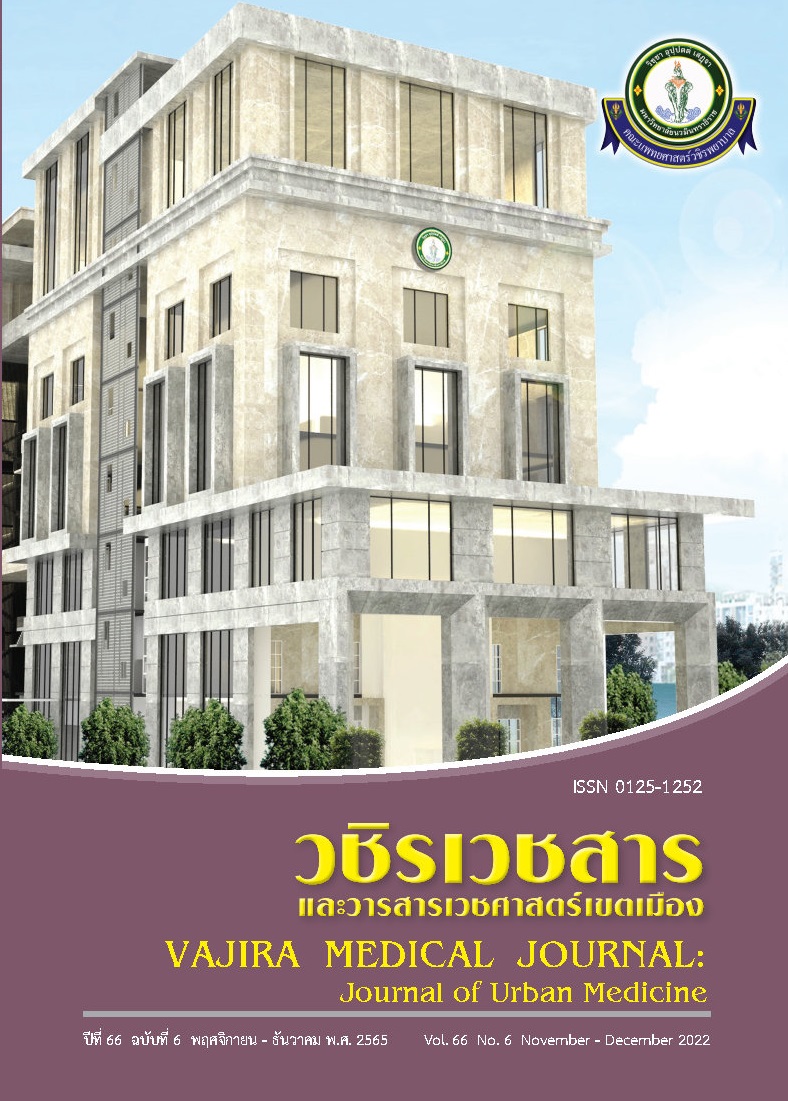Spironolactone to Prevent the Progression of Vascular Calcification among Peritoneal Dialysis Patients: A Pilot Randomised Controlled Trial (SV-CAPD trial)
Main Article Content
Abstract
Objective: The purpose of the study was to investigate the efficacy and safety of spironolactone to prevent vascular calcification among peritoneal dialysis patients.
Methods: This study was a randomised, double-blinded placebo-controlled trial conducted from August 2018 to December 2020 at Vajira Hospital, Thailand. We randomly assigned peritoneal dialysis patients to receive either 25 mg of spironolactone daily or a placebo for 6 months. Coronary artery calcium scores and laboratory tests were performed and compared at baseline, and 6 months thereafter.
Results: Among the 40 patients initially randomised, 34 patients completed the study (17 patients in the spironolactone group and 17 patients in the placebo group). There was no difference in baseline characteristics or laboratory results between both groups. The spironolactone group showed a significant reduction in CACs at 6 months (169.97 AU [IQR 2.34 - 1146.29] to 92.29 AU [IQR 4.83 - 851.1], p=0.05). Compared to placebo, spironolactone had a lower percentage change in CACs (0% [IQR -47.1-14.7] vs 6.06% [IQR -1.9-40.8], p=0.07. However, the change in the absolute progression of CACs was not different (0 AU [IQR -30.5-58.3] in the spironolactone group vs 6.14 AU [IQR -13.9-331.2] in the placebo group). Spironolactone also showed significantly lower serum phosphorus and osteocalcin (3.8 ± 1.3 mg/dL vs 4.8 ± 1.1 mg/dL and 69.0 ng/mL [IQR 41.9-151.5] vs 178.0 ng/mL [IQR 86.8-269.5], p=0.02 and 0.014, respectively). No hyperkalaemia or hypotension was found in either group.
Conclusion: Among peritoneal dialysis patients, spironolactone showed a potential benefit to prevent the progression of vascular calcification. Further studies with a larger population and long-term follow-up should be conducted.
Downloads
Article Details

This work is licensed under a Creative Commons Attribution-NonCommercial-NoDerivatives 4.0 International License.
References
Kidney Disease: Improving Global Outcomes (KDIGO) CKD-MBD Work Group. KDIGO clinical practice guideline for the diagnosis, evaluation, prevention, and treatment of Chronic Kidney Disease-Mineral and Bone Disorder (CKD-MBD). Kidney Int Suppl 2009;(113):S1-130.
Budoff MJ, Mayrhofer T, Ferencik M, Bittner D, Lee KL, Lu MT, et al. Prognostic value of coronary artery calcium in the PROMISE study (prospective multicenter imaging study for evaluation of chest pain). Circulation 2017;136(21):1993-2005.
Moradi M, Nouri S, Nourozi A, Golbidi D. Prognostic value of coronary artery calcium score for determination of presence and severity of coronary artery disease. Pol J Radiol 2017;82:165-9.
Disthabanchong S, Srisuwarn P. Mechanisms of vascular calcification in kidney disease. Adv Chronic Kidney Dis 2019;26(6):417-26.
Lang F, Ritz E, Alesutan I, Voelkl J. Impact of aldosterone on osteoinductive signaling and vascular calcification. Nephron Physiol 2014;128(1-2):40-5.
Fischer SS, Kempe DS, Leibrock CB, Rexhepaj R, Siraskar B, Boini KM, et al. Hyperaldosteronism in Klotho-deficient mice. Am J Physiol Renal Physiol 2010;299(5):F1171-7.
Tatsumoto N, Yamada S, Tokumoto M, Eriguchi M, Noguchi H, Torisu K, et al. Spironolactone ameliorates arterial medial calcification in uremic rats: the role of mineralocorticoid receptor signaling in vascular calcification. Am J Physiol Renal Physiol 2015;309(11):F967-79.
Matsumoto Y, Mori Y, Kageyama S, Arihara K, Sugiyama T, Ohmura H, et al. Spironolactone reduces cardiovascular and cerebrovascular morbidity and mortality in hemodialysis patients. J Am Coll Cardiol 2014;63(6):528-36.
Ito Y, Mizuno M, Suzuki Y, Tamai H, Hiramatsu T, Ohashi H, et al. Long-term effects of spironolactone in peritoneal dialysis patients. J Am Soc Nephrol 2014;25(5):1094-102.
Yongsiri S, Thammakumpee J, Prongnamchai S, Tengpraettanakorn P, Chueansuwan R, Tangjaturonrasme S, et al. Randomized, doubleblind, placebo-controlled trial of spironolactone for hypokalemia in continuous ambulatory peritoneal dialysis patients. Ther Apher Dial 2015;19(1):81-6.
Wilson PW, Kauppila LI, O'Donnell CJ, Kiel DP, Hannan M, Polak JM, et al. Abdominal aortic calcific deposits are an important predictor of vascular morbidity and mortality. Circulation 2001;103(11):1529-34.
Foley RN, Parfrey PS, Sarnak MJ. Clinical epidemiology of cardiovascular disease in chronic renal disease. Am J Kidney Dis 1998;32 (5 Suppl 3):S112-9.
Block GA, Spiegel DM, Ehrlich J, Mehta R, Lindbergh J, Dreisbach A, et al. Effects of sevelamer and calcium on coronary artery calcification in patients new to hemodialysis. Kidney Int 2005;68(4):1815-24.
Chertow GM, Burke SK, Raggi P; Treat to Goal Working Group. Sevelamer attenuates the progression of coronary and aortic calcification in hemodialysis patients. Kidney Int 2002;62(1): 245-52.
Gueiros APS, Gueiros JEB, Nóbrega KT, Calado EB, Matta MCD, Torres LC, et al. Effect of spironolactone on the progression of coronary calcification in peritoneal dialysis patients: a pilot study. J Bras Nefrol 2019;41(3):345-55.
Gao J, Zhang K, Chen J, Wang MH, Wang J, Liu P, et al. Roles of aldosterone in vascular calcification: An update. Eur J Pharmacol 2016;786:186-93.
Wu M, Rementer C, Giachelli CM. Vascular calcification: an update on mechanisms and challenges in treatment. Calcif Tissue Int 2013;93(4):365-73.
Lang F, Leibrock C, Pelzl L, Gawaz M, Pieske B, Alesutan I, et al. Therapeutic interference with vascular calcification-lessons from klotho-hypomorphic mice and beyond. Front Endocrinol (Lausanne) 2018;9:207.
Jansz TT, van Reekum FE, Özyilmaz A, de Jong PA, Boereboom FTJ, Hoekstra T, et al. Coronary artery calcification in hemodialysis and peritoneal dialysis. Am J Nephrol 2018;48(5): 369-77.
Feniman-De-Stefano GM, Zanati-Basan SG, De Stefano LM, Xavier PS, Castro AD, Caramori JC, et al. Spironolactone is secure and reduces left ventricular hypertrophy in hemodialysis patients. Ther Adv Cardiovasc Dis 2015;9(4): 158-67.


